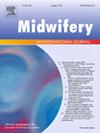Acupoint stimulation combined with transcutaneous electrical nerve stimulation on labour pain: A stepped wedge cluster randomised controlled trial
IF 2.6
3区 医学
Q1 NURSING
引用次数: 0
Abstract
Background
Labour pain management remains a critical concern, as pharmacological methods often carry side effects and potential risks. Non-pharmacological approaches, such as acupoint stimulation and transcutaneous electrical nerve stimulation (TENS) are being explored as viable alternatives. However, evidence regarding their combined use and overall effect on maternal and fetal outcomes remains limited.
Aim
This study aimed to evaluate the effectiveness of acupoint stimulation combined with TENS on labour pain, delivery outcomes, and childbirth experience for women undergoing a trial of labour.
Methods
A parallel multi-arm, stepped wedge cluster randomized controlled trial was conducted with 600 women randomized into four groups: TENS, acupoint stimulation, TENS combined with acupoint stimulation, and a control group. The study assessed Visual Analog Scale (VAS) scores, Non-Pharmacological to Pharmacological Pain Management Interval (NPI), the rate of epidural analgesia, delivery outcomes, and childbirth experience.
Results
After intervention, women's VAS scores in the TENS, acupoint stimulation, and combined groups were significantly lower than the control group at multiple time points (at 30 , 90, 120, 150, 180, 210, 240, and 270 min, P < 0.05). Non-pharmacological to pharmacological pain management intervals (NPIs) were significantly longer in all intervention groups compared to the control group (P < 0.001), with median NPIs ranging from 178 to 183.5 min in the intervention groups versus 104 min in the control group. A positive correlation was observed between NPI and childbirth experience scores (r = 0.101, P < 0.05). No significant differences were found in epidural analgesia rates, delivery outcomes, postpartum bleeding, Apgar scores, labour duration, or perineal tear rates (all P > 0.05). Childbirth experience scores (CEQ) were significantly higher in the TENS and combined groups compared to the control group (P < 0.01).
Conclusion
Acupoint stimulation combined with TENS is an effective non-pharmacological approach for alleviating labour pain and enhancing the overall childbirth experience. This integrated method is recommended for incorporation into labour pain management protocols, providing women with a valuable alternative or adjunct to pharmacological interventions.
穴位刺激联合经皮神经电刺激治疗阵痛:一项阶梯楔形聚类随机对照试验
分娩疼痛管理仍然是一个关键问题,因为药理学方法往往带有副作用和潜在风险。非药物方法,如穴位刺激和经皮神经电刺激(TENS)正在探索作为可行的替代方案。然而,关于它们的联合使用和对母婴结局的总体影响的证据仍然有限。目的本研究旨在评价穴位刺激联合TENS对临产妇女阵痛、分娩结局和分娩体验的影响。方法采用平行多臂、阶梯楔形聚类随机对照试验,将600名女性随机分为TENS组、穴位刺激组、TENS联合穴位刺激组和对照组。该研究评估了视觉模拟量表(VAS)评分、非药物到药物疼痛管理间隔(NPI)、硬膜外镇痛率、分娩结局和分娩经验。结果干预后,TENS组、穴位刺激组和联合组在多个时间点(30、90、120、150、180、210、240、270 min)的VAS评分均显著低于对照组,P <;0.05)。与对照组相比,所有干预组的非药物到药物疼痛管理间隔(npi)明显更长(P <;0.001),干预组的npi中位数为178 - 183.5 min,对照组为104 min。NPI与分娩经验评分呈正相关(r = 0.101, P <;0.05)。硬膜外镇痛率、分娩结局、产后出血、Apgar评分、分娩持续时间或会阴撕裂率均无显著差异(P >;0.05)。分娩经验评分(CEQ)在TENS组和联合组显著高于对照组(P <;0.01)。结论穴位刺激联合TENS是一种有效的非药物方法,可减轻分娩疼痛,提高整体分娩体验。建议将这种综合方法纳入分娩疼痛管理方案,为妇女提供有价值的替代或辅助药物干预。
本文章由计算机程序翻译,如有差异,请以英文原文为准。
求助全文
约1分钟内获得全文
求助全文
来源期刊

Midwifery
医学-护理
CiteScore
4.50
自引率
7.40%
发文量
221
审稿时长
13.4 weeks
期刊介绍:
Midwifery publishes the latest peer reviewed international research to inform the safety, quality, outcomes and experiences of pregnancy, birth and maternity care for childbearing women, their babies and families. The journal’s publications support midwives and maternity care providers to explore and develop their knowledge, skills and attitudes informed by best available evidence.
Midwifery provides an international, interdisciplinary forum for the publication, dissemination and discussion of advances in evidence, controversies and current research, and promotes continuing education through publication of systematic and other scholarly reviews and updates. Midwifery articles cover the cultural, clinical, psycho-social, sociological, epidemiological, education, managerial, workforce, organizational and technological areas of practice in preconception, maternal and infant care.
The journal welcomes the highest quality scholarly research that employs rigorous methodology. Midwifery is a leading international journal in midwifery and maternal health with a current impact factor of 1.861 (© Thomson Reuters Journal Citation Reports 2016) and employs a double-blind peer review process.
 求助内容:
求助内容: 应助结果提醒方式:
应助结果提醒方式:


